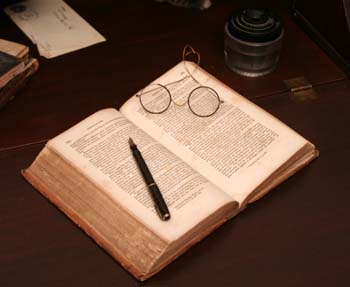AMPUTATION BELOW
THE KNEE.
 In the thigh, amputation is
done as low as the case will allow. In the leg, the common practice is
to make the incision through the integuments sufficiently low, to enable
the operator to saw the bones, about four inches below the lower part of
the patella. This is necessary, in order to have a sufficient surface in
front of the limb for the application of a wooden leg, and not to
deprive the stump of that power of motion, which arises from the flexor
tendons of the leg continuing undivided.
In the thigh, amputation is
done as low as the case will allow. In the leg, the common practice is
to make the incision through the integuments sufficiently low, to enable
the operator to saw the bones, about four inches below the lower part of
the patella. This is necessary, in order to have a sufficient surface in
front of the limb for the application of a wooden leg, and not to
deprive the stump of that power of motion, which arises from the flexor
tendons of the leg continuing undivided.
The tourniquet should be
applied to the femoral artery, two-thirds of the way down the thigh,
just before the vessel perforates the tendon of the triceps muscle; this
is a much more convenient situation than the ham. The leg being properly
held, the integuments should next be drawn upward by an assistant, while
the surgeon, with one quick stroke of the knife, divides the skin
completely round the limb.
Some recommend the operator to
stand on the inside of the leg, in order that he may be able to saw the
bones at once. No reflections could ever make me perceive, that any real
advantage ought strictly to be imputed to this plan. I know, many fancy
that it diminishes the chance of the fibula being splintered, as this
bone is completely divided rather sooner than the tibia. But, as
splintering the bones arises from the assistant, who holds the leg,
depressing the limb too much, it would be difficult to explain, why the
two bones should not be splintered, when a certain thickness of them had
been sawn through, if the leg were too forcibly depressed.
Having made a circular division
of the integuments, the next object is, to preserve skin enough to cover
the front of the tibia, and the part of the stump corresponding to the
situation of the tibialis anticus, extensor longus pollicis, and other
muscles, between the tibia and fibula, including those covering the
latter bone. Throughout this extent, there are no bulky muscles which
can be made very serviceable in covering the end of the stump, and
consequently the operator must here have sufficient skin, by dissecting
it up, and turning it backwards.
On the posterior part of the
leg, the skin should never he detached from the large gastrocnemius
muscle, which, when obliquely divided, will, with the soleus, here form
a sufficient mass for covering the stump. Hence, as soon as the skin has
been separated in front, and on the outside of the leg, the surgeon is
to place the edge of the knife in the incision of the integuments, and
cut in the Alansonian way through the muscles of the calf, from the
inside of the tibia, quite to the fibula. Then the flap, formed by the
calf of the leg, is to be held back by the assistant, while the surgeon
completes the division of the rest of the muscles, together with the
interosseous ligament, by means of the catling, or a long, very narrow,
double-edged knife.
In amputating below the knee,
particular care must be taken to cut every fasciculus of muscular fibres,
before the saw is used. Every part being divided, except the bones, the
soft parts are next to be protected from the saw, by a linen retractor,
made with three tails, one of which is to be drawn through the space,
between the tibia and fibula.
In the leg, only three
principal arteries require ligatures; viz. the anterior and posterior
tibial, and the peroneal, arteries.
When the wound is to be
dressed, the soft parts, preserved for covering the bones, should be
brought together, so as to make the line of their union not transverse,
but obliquely perpendicular, the lower end of it being more external
than the upper. Thus the tibia and fibula may be effectually covered,
without the strips of adhesive plaster forcibly pressing the skin
against the sharp edge of the tibia. The plaster, which makes most
pressure, should go over the. centre of the stump, at the point
corresponding to the interosseous space.
 In the thigh, amputation is
done as low as the case will allow. In the leg, the common practice is
to make the incision through the integuments sufficiently low, to enable
the operator to saw the bones, about four inches below the lower part of
the patella. This is necessary, in order to have a sufficient surface in
front of the limb for the application of a wooden leg, and not to
deprive the stump of that power of motion, which arises from the flexor
tendons of the leg continuing undivided.
In the thigh, amputation is
done as low as the case will allow. In the leg, the common practice is
to make the incision through the integuments sufficiently low, to enable
the operator to saw the bones, about four inches below the lower part of
the patella. This is necessary, in order to have a sufficient surface in
front of the limb for the application of a wooden leg, and not to
deprive the stump of that power of motion, which arises from the flexor
tendons of the leg continuing undivided.